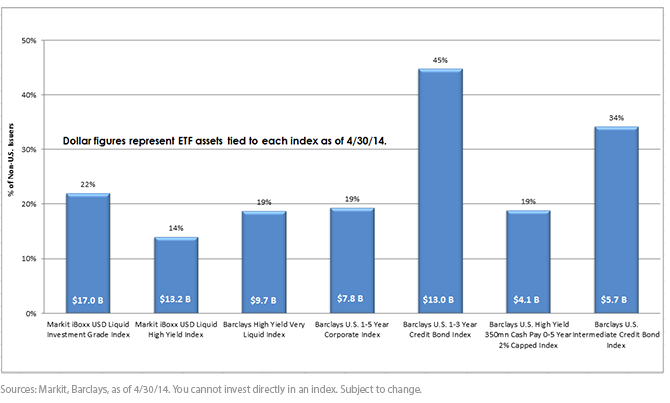Where in the World Does Your U.S. Bond ETF Invest?


 For definitions of terms and Indexes in the chart, please visit our glossary.
In our view, they shouldn’t. Through a potentially troublesome combination of low interest rates, narrowing credit spreads and industrial releveraging, blindly lending companies around the world money could be a less-than-prudent approach. Of the nearly $71 billion in assets currently benchmarked against the Indexes above, 25%, or $17.5 billion, is invested in companies and governments outside of the United States.2 With a wide array of potential opportunities (and pitfalls) cropping up in economies around the world, we believe investors should be conscious of the risks they are taking and start to think strategically about their corporate bond allocations. Taking this a step further, an active approach to fixed income can potentially benefit investors by drawing on the expertise of a portfolio management team whose sole focus is to identify which risks are worth taking. At the same time, it may be possible that a passive approach can outperform in certain market scenarios. Although there are no guarantees in investing, actively managed ETFs publish holdings daily so you always know what you hold.
One way we believe that the WisdomTree Strategic Corporate Bond Fund* (CRDT) can potentially add value to investors’ portfolios is by striking a balance based on fundamentals, not only between credit quality and corporate sectors, but also across geographic exposures. In much the same way that investors seek to take advantage of comparatively attractive opportunities in foreign equities, CRDT has a broad mandate to invest in the U.S. as well as around the world.
*Formerly WisdomTree Global Corporate Bond Fund (GLCB).
1Source: Kenneth R. French and James M. Poterba, “Investor Diversification and International Equity Markets,” National Bureau of Economic Research, 1991.
2Sources: WisdomTree, Markit, Barclays, as of 4/30/14.
For definitions of terms and Indexes in the chart, please visit our glossary.
In our view, they shouldn’t. Through a potentially troublesome combination of low interest rates, narrowing credit spreads and industrial releveraging, blindly lending companies around the world money could be a less-than-prudent approach. Of the nearly $71 billion in assets currently benchmarked against the Indexes above, 25%, or $17.5 billion, is invested in companies and governments outside of the United States.2 With a wide array of potential opportunities (and pitfalls) cropping up in economies around the world, we believe investors should be conscious of the risks they are taking and start to think strategically about their corporate bond allocations. Taking this a step further, an active approach to fixed income can potentially benefit investors by drawing on the expertise of a portfolio management team whose sole focus is to identify which risks are worth taking. At the same time, it may be possible that a passive approach can outperform in certain market scenarios. Although there are no guarantees in investing, actively managed ETFs publish holdings daily so you always know what you hold.
One way we believe that the WisdomTree Strategic Corporate Bond Fund* (CRDT) can potentially add value to investors’ portfolios is by striking a balance based on fundamentals, not only between credit quality and corporate sectors, but also across geographic exposures. In much the same way that investors seek to take advantage of comparatively attractive opportunities in foreign equities, CRDT has a broad mandate to invest in the U.S. as well as around the world.
*Formerly WisdomTree Global Corporate Bond Fund (GLCB).
1Source: Kenneth R. French and James M. Poterba, “Investor Diversification and International Equity Markets,” National Bureau of Economic Research, 1991.
2Sources: WisdomTree, Markit, Barclays, as of 4/30/14.Important Risks Related to this Article
There are risks associated with investing, including possible loss of principal. Foreign investing involves special risks, such as risk of loss from currency fluctuation or political or economic uncertainty. Investments in emerging, offshore or frontier markets are generally less liquid and less efficient than investments in developed markets and are subject to additional risks, such as risks of adverse governmental regulation and intervention or political developments. Derivative investments can be volatile, and these investments may be less liquid than other securities, and more sensitive to the effects of varied economic conditions. Fixed income investments are subject to interest rate risk; their value will normally decline as interest rates rise. In addition, when interest rates fall, income may decline. Fixed income investments are also subject to credit risk, the risk that the issuer of a bond will fail to pay interest and principal in a timely manner, or that negative perceptions of the issuer’s ability to make such payments will cause the price of that bond to decline. Unlike typical exchange-traded funds, there is no index that the Fund attempts to track or replicate. Thus, the ability of the Fund to achieve its objective will depend on the effectiveness of the portfolio manager. Please read the Fund’s prospectus for specific details regarding the Fund’s risk profile.

Rick Harper serves as the Chief Investment Officer, Fixed Income and Model Portfolios at WisdomTree Asset Management, where he oversees the firm’s suite of fixed income and currency exchange-traded funds. He is also a voting member of the WisdomTree Model Portfolio Investment Committee and takes a leading role in the management and oversight of the fixed income model allocations. He plays an active role in risk management and oversight within the firm.
Rick has over 29 years investment experience in strategy and portfolio management positions at prominent investment firms. Prior to joining WisdomTree in 2007, Rick held senior level strategist roles with RBC Dain Rauscher, Bank One Capital Markets, ETF Advisors, and Nuveen Investments. At ETF Advisors, he was the portfolio manager and developer of some of the first fixed income exchange-traded funds. His research has been featured in leading periodicals including the Journal of Portfolio Management and the Journal of Indexes. He graduated from Emory University and earned his MBA at Indiana University.

